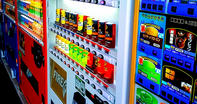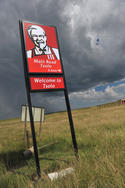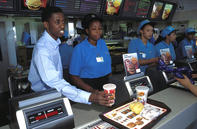Demands of City Living
‘The majority of local shops sell cheap fatty foods. Street vendors’ stalls sell fatty meat and sausages,’ one person said. ‘To drink low-fat milk is impractical,’ said another. ‘It is not available in our shops.’ The convenience of this kind of food fits so easily into the demands of surviving in a sprawling city.

Now, factory-produced foods, fast foods and eat-on-the-hoof foods sold on the street have replaced the time-hungry, energy-consuming chore of stocking the pantry and cooking at home. It has cut a person’s tether to the home kitchen and allowed them to roam free in the city, foraging as they go.
The demands of city living – hours and hours at work, time spent commuting, the seductive lure of the TV and the couch – give us less time to gather and prepare food, and the ever-present Kentucky Fried Chicken (KFC), Nando’s or vendors selling Nik Naks on the side of the road make it all too easy to fill the hole in the belly, but not with the kind of food that nourishes us in the long term.
In urban areas, men and women are driven into the workforce by the overriding need for an increase in income to pay for food, shelter, clothing and other household expenses. There is simply less time left to think about food at home, since more and more people in a single home find themselves getting absorbed into the job market.
And once they do, their long hours and commutes do not leave too much time for chopping vegetables or scrubbing pots. These factors have fuelled demand and led to massive market expansion of convenience and fast food options. Traditional meals and meal times are replaced by spontaneous often unplanned food purchases on street corners or in small kiosks.
The traditional model of one family member taking responsibility for meal planning and food preparation for the household has fractured in most urban environments. Increasingly it is street food vendors, cafeterias at work or school and child care facilities that provide family members with at least one and often several meals per day. Attention to dietary balance and dietary quality, which was traditionally “intuitive” at the household level, is now subject to wider cultural changes and external influence.
Capitalism at its Best
When apartheid finally began to crumble from 1990 onwards, the barricades to global trade were torn down. Trade embargoes, sanctions and ill geo-political will towards the country vaporised, and into the vacuum flooded free-market capitalism at its best. And with it came the multinational food giants.
This, too, has left its mark on the ecosystem of the urban food habitat. By 1997, South Africa was Coca-Cola’s most important African market, with an advertising budget behind it of US$25 million, making Coca-Cola one of the top ten advertisers in the country at the time.
Even though some of these multinational fast food chains are spreading their reach into other countries in southern Africa, they are overwhelmingly concentrated in South Africa – it is one of the largest markets for KFC. In 2004, there were over 300 KFC’s around the country; now there are over 500 in southern Africa, and more planned. McDonald’s exploded onto the scene, firing up their deep-frying cookers in 30 outlets in just 26 months following the opening of their first store in Jo’burg in 1995.
By 2004, there were 103 outlets (in industry parlance, they are called ‘restaurants’, but even though they fit the dictionary definition of the word, one might be hesitant to lump these establishments into the same category as one with braised beef ravioli or prosciutto-wrapped asparagus on the menu) almost all in cities, and today there are 148 outlets.
South Africa's Fast Food Market

‘South Africa is one of the most successful markets in McDonald’s international history,’ crows the McDonald’s South Africa website. A record was set when South Africa opened 30 restaurants in just 23 months, at one stage opening 10 restaurants in 78 days.
McDonald’s already invested more than R750-million directly into the South African economy and were committed to the success of the South African market. True, big business like this does fuel the economy at one level. But how much does the consumption of its products contribute to the state’s healthcare burden?
The business media giant Bloomberg reported in 2010 that there are now ‘more than 600 KFCs in South Africa’ and that the ‘chicken chain has a 44% share of that country’s US$1.8 billion fast-food market, followed by South African chain Nando’s, with 6%, and McDonald’s and the local Chicken Licken, each with a 5% share’.
Africa’s urbanisation trend is one of the reasons the continent suddenly looks so appealing to many of the multinationals because of the basic scales of economy – in high-density urban living, food retail opportunities become plentiful.
Fast Food Franchise Growth in Africa
Even though the first KFC opened in South Africa in 1971, well before the post-apartheid opening up of markets, the fast food franchise’s growth on the rest of the continent has been negligible. But this appears to be changing.
According to the Bloomberg report late in 2010, the parent company of KFC, Yum Brands Inc., announced then that it planned to double its presence on the continent, aiming for 1 200 outlets in just four years, and at the same time hopes to double its revenue to US$2 billion.
Yum chairman David Novak is quoted as saying that Africa ‘wasn’t even on the radar screen 10 years ago, but now they see it exploding with opportunity’, partly because chicken is such a staple food on the continent, partly because the scales of economy of reaching an expanding, high-density urban population make such good business sense, and partly because in some African communities, people are getting richer.
‘The number of households with discretionary income is projected to increase by 50% to 128 million over the next decade, according to a recent study by the McKinsey Global Institute,’ states the Bloomberg report. Curiously, according to this report, the African market prefers meat on the bone to processed chicken like the nuggets or boneless breasts, and KFC’s products are being priced right, from the wealthy down to those living at ‘an income level just above that of subsistence farming’.
Some of the combo-meals are priced at anything from US$7 for a chicken sandwich, chips and a drink, down to US$1 for a straight chicken sandwich or four chicken wings for US$1. The bespectacled, goateed face of Colonel Sanders and his deep-fried battered chicken embody what cities are to many of us, and how they have changed our palate.
Out go those old provincial foods; in come the big-brand, high-octane, overly processed, fast foods that are packed with flavour and not much else.
A Hit of Greasy Fast Food

This nutritional transition is happening all over the developing world as people abandon traditional diets for ones that are less diverse, lower in fibre and energy-dense. It is food that is quick to get, tasty and often cheap. For many people, it is about everything that is modern and sophisticated.
KFC is one of the most prominent aspirational food brands, and people often save up for weeks to buy a single meal that would equate to small change for many middle-class people, or they will take their family there as a special outing. This kind of food is relatively cheap.
For a cash-strapped family, there is nothing like a hit of greasy fast food that costs so much less than cooking up something similar at home, and with none of the effort. And the problem with the human body is that it is easy to drive out the immediate discomfort of hunger by bulking up on cheap, empty, tasty calories without meeting the body’s long-term nutritional needs.
By Leonie Joubert